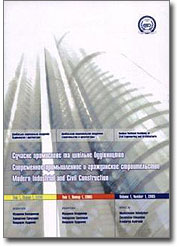Theoretical and applied issues of dynamic certification of the retaining wall in earthquake-prone regions of Ukraine
Abstract: Technical maintenance and following certification of buildings and structures is a priority milestone to ensure the necessary and economically viable level of seismic resistance of construction projects in terms of moral and physical deterioration, seismic hazard refinement and further development of existing standards for design and construction in seismic regions of Ukraine. Certification of buildings and structures (BS) serve two main purposes: comparative assessment of the actual seismic stability of BS with refined seismic areas (definition of seismic resistance deficit BS); identification of the most earthquake-prone sites requiring priority amplification or conversion. The article examines the theoretical and methodological and practical issues of dynamic certification facilities of the retaining wall and drainage gallery in the city of Chernovtsy. Existing methods of certification can be divided into three groups: methods of expert assessments, computational and analytical methods, methods of technical diagnostics. By virtue of the above-described advantages and disadvantages inherent in each of the three approaches, methodological problems of certification can be reduced to two major problems. The first problem — it is the correct definition of the criterion in the evaluation of seismic stability of the surveyed buildings or structures: expert assessment, reflecting the degree of compliance with requirements of the design object DBN; settlement and analytical evaluation of seismic resistance, seismic loads corresponding conditional on DBN, the results of technical diagnostics BS. The second problem — the definition of the required level of exposure at which explores the dynamic structure of buildings: micro dynamic level during the elastic stage of construction or load level corresponding to the work of building structures beyond the elastic limit. Shown how to use the equipment may be carried seism metric analysis of free oscillations of small amplitude of BS get their dynamic characteristics: the main periods and forms of free oscillations, logarithmic decrement, etc. At the level of a single DBN or standard common method of dynamic certification today in Ukraine don’t exist now. For this reason, improving methods of examination to evaluate their actual seismic stability, including taking into account the physical deterioration of structures, is an urgent task. The analysis of free oscillations of BS can obtain the following dynamic characteristics: the main periods and forms of free vibrations of buildings and structures, the logarithmic decrement, etc. As a result of the dynamic certification of the retaining wall and drainage gallery in the city of Chernovtsy, necessary dynamic data had obtained. According to the results of the dynamic certification and technical survey prepared appropriate recommendations that have already taken into account by local authorities Chernovtsy for reconstruction projects and reconstruction of drainage gallery.
Keywords: free vibrations, certification, retaining wall.
Pages: 5-14.
For citation:
For citation: Khavkin, C. A.; Kaliukh, Iu. I. Theoretical and applied issues of dynamic certification of the retaining wall in earthquake-prone regions of Ukraine. – Text : electronic. – In: <em>Modern Industrial and Civil Construction</em>. – 2014. – Vol. 10, N 1. – Р. 5-14. – URL: https://donnasa.ru/publish_house/journals/spgs/2014-1/01_khavkin_kaliukh.pdf (date of access: 22.12.2024). – ISSN 1993-3495.

Vol. 10, N 1 (2014)
Journal: Modern Industrial and Civil Construction
Publish house: Donbas National Academy of Civil Engineering and Architecture
Journal: Modern Industrial and Civil Construction
Publish house: Donbas National Academy of Civil Engineering and Architecture
